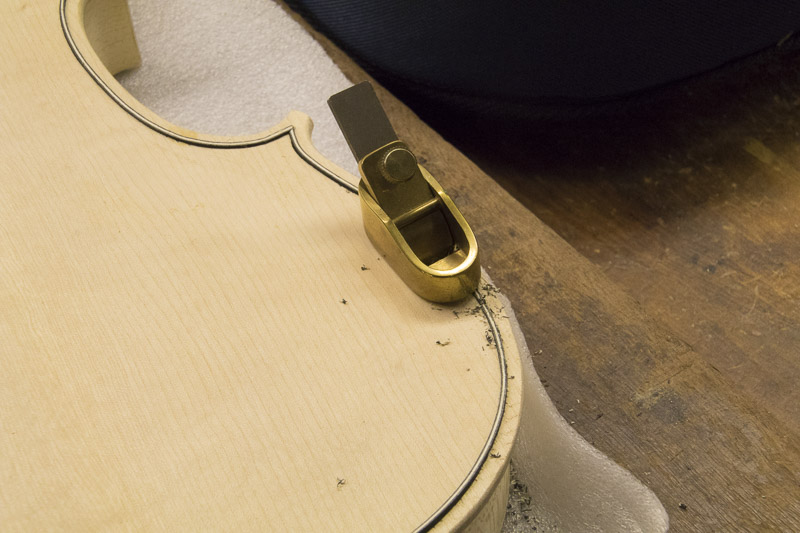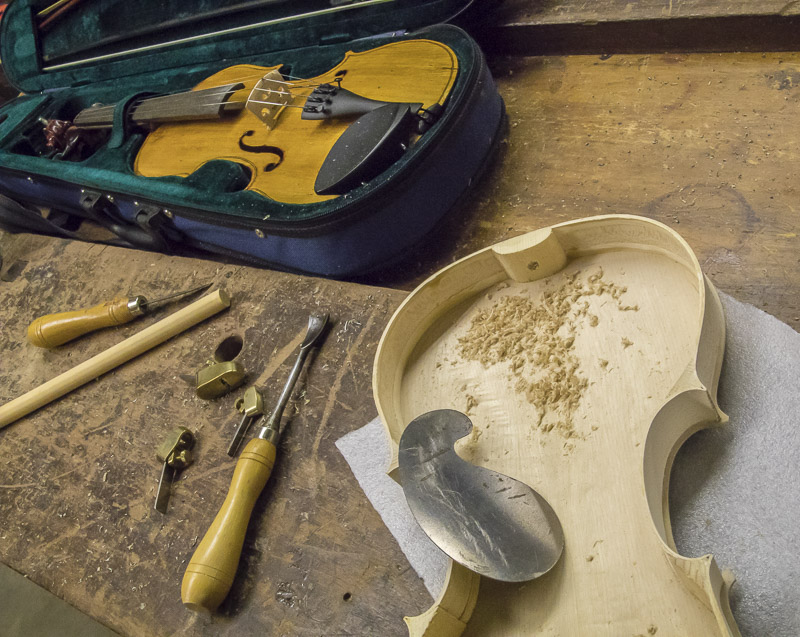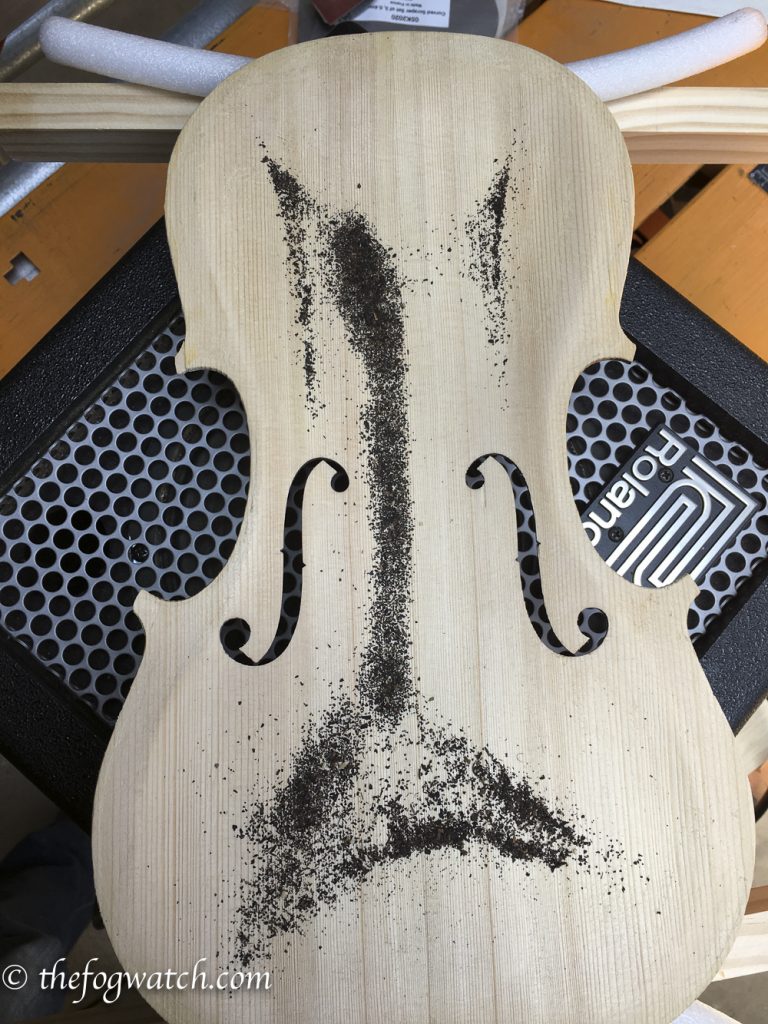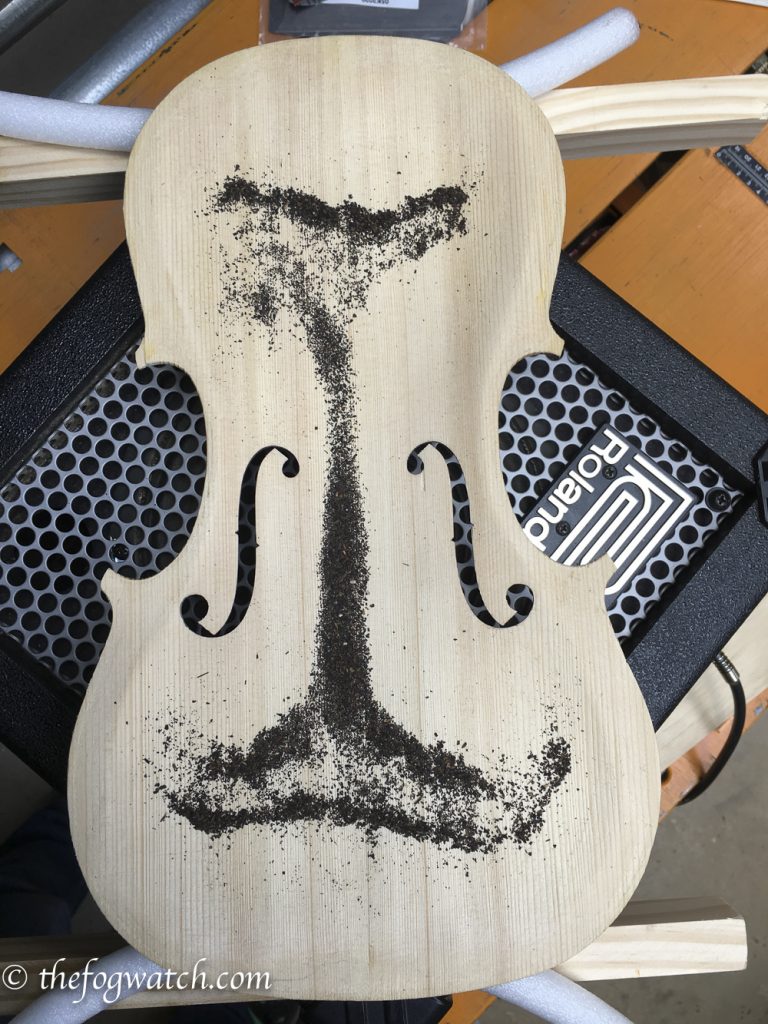Do you approach travel with excitement or trepidation? How do you find calm amidst the excitement? And importantly, how do you balance these to get the most out of travel, and out of life more generally? It seems to me, that to get the most out of our travel, we need to be:
- responsive to our environment,
- aware of our surroundings, and
- calm within ourselves.
How we achieve a balance between these aspects can influence how we experience our travel.
As a musician and luthier, I find that these aspects can easily be applied to violin making. For a violin to have good tone, it must be responsive, both to the inputs from the strings but also to the environment. And at the same time, in order to produce a good well-rounded tone, there must be a harmony between the responsive parts and the calm parts of each plate of the sound box. Examining this is a bit like reading the Chladni patterns on a violin plate, showing how harmoniously it vibrates in response to excitement.

Between travels, I have been making a violin – my second – and some people have asked me what I do to make a violin have a good sound. As with my first, I have tried to take time to tune each plate so that it is responsive across a range of frequencies. Every piece of wood is different, after all, it is an organic material that has grown in its own environment and has been subject to unique weather patterns, and cycles between winter and summer, resulting in unique growth patterns (the same applies to people too!). For that reason, you can’t just measure a Stradivarius violin and machine the timbers of a new one to exactly the same thickness across each plate and expect a Stradivarius violin to emerge. I think there is both an art and a science to it.

It is possible to measure the responsiveness of a violin plate at different frequencies, but perhaps more importantly, we need to be able to see where the plate is responsive, and where it is not. Any block of wood can be tuned like a xylophone block to ring to a particular note, but it is the pattern of vibration that provides the tone.
I use a fairly crude means to do this, but it seems to work. I suspend the plate I’m working on over an amplifier/speaker – in this case, a 15W Roland Cube amp placed so that the speaker faces upward. I set the plate on a couple of pieces of foam polystyrene over the speaker. I then use a tone generator on my phone (yes there’s an app for that!) and play tones smoothly rising from 10 beats per second (10 Hertz) up to 1000 Hertz.
So how do I see the vibration patterns? I take a tea bag – actually, any lightweight powder will do – you could use poppy seeds or dark sawdust too – and sprinkle a random pattern evenly over the plate. Then I play tones gradually rising in frequency. At different frequencies, the tea leaves will bounce and move where the plate is responsive, and they will stay still where the plate is not responding. In this case, the plate responds to its resonant frequency, which is 190 Hertz – which falls between F# and G. This is good because it means it won’t ring out suddenly when a properly tuned note is played.

Initially, the patterns are thick and often unbalanced. I then take a photo, and draw with chalk lightly around where the tea leaves are settled, and gently remove shavings of wood, a little at a time, with a scraper from within the chalked area. Then I re-sprinkle the tea leaves and repeat the process until I have a nice pattern – like a frown and moustache – that are well balanced and have a nice form. Every plate is different and varies in density, but the patterns shouldn’t have gaps or wild inconsistencies. The technical term for these patterns is Chladni patterns, named for Ernst Chladni, who first visualised the patterns. The tea leaves collect where there is no vibration – these areas are called ‘nodes’. Where the vibration is greatest, these are called ‘anti-nodes’.

Just as when we travel we seek a balance between periods of excitement and periods of calm, so too we need a nice balance between the nodes and the anti-nodes. There will be changes, of course, to these vibration patterns when the violin is assembled as against being a free plate, but I work on the basis that if each part is tuned well, then it will also work well collectively when it is assembled.
Again, the same is true of people – if each member of a group is well attuned, the group itself will perform well. This is why emotional intelligence is so important to good group dynamics. Conversely, if one part of the group is not emotionally aware, the whole tone of the group, or the tour, or the holiday can be dampened. I hope your ‘Chladni’ patterns are nicely formed too!
Okay, I drew a long bow here, but while this post tells you something about violin making, it also shows how different aspects of our lives can be seen metaphorically to apply to one’s whole philosophical approach to life. All things are connected in their way, and find resonance in unexpected places.


I know a lot more now – Looking at my two violins with other eyes and – would love to – with other ears….can‘t play them anymore. I am going to sell them one day.
Thanks Anneliese – For years I have played without fully understanding what it is about the construction of a violin that makes the sound unique, so a couple of years ago I began making my first one and now onto the second with more learned each time. They are wonderful instruments in which each component supports the other to work in concert to make the sound 🙂
Hi Jerry, wonderful read as always. You are so talented on so many levels. A very thoughtful and interesting post.
Thanks Kathy – I certainly like to give things a go – I have learned over the years that we have so many ‘black box’ things and yet I find myself wondering ‘how did they do that?’ At which point I try to get over my reticence. In this case, I decided that a violin is essentially a box with a handle and some strings. Then taking it further I realised that the curves in the wood add strength and reduce the need for mass/weight. And then I realised that individually I could probably make each part and put it all together. It is a slow process, but the Camino has taught me not to rush things so much as I used to 🙂
I quite enjoyed the read Jerry, especially the link to team dynamics. Whilst it may be possible to get them all to resonate them at once, I guess leadership would be pulling the natural frequency to some driven/desired state. Makes for a good problem, System Identification of a group of people – never considered that really.
Anyway loved the description of the violin construction problem – very fascinating, especially for the non-musical of us (oh, I wish it was not so!).
Thanks.
Thanks Ashley – I’m glad you enjoyed the link to team dynamics – we are all individuals, and in that diversity is strength as each works with each other’s strengths.
Love this. Especially using tea leaves to find the balance. Lovely way of pulling it into a life lesson.
Thanks Maggie – yes it can be so useful reading the tea leaves 😉